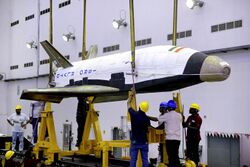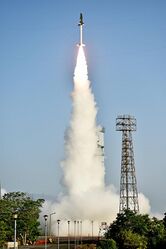Astronomy:RLV-TD
 Technology Development Vehicle (TDV) for RLV Technology Demonstration Programme at Satish Dhawan Space Centre | |
| Function | Technology demonstration vehicle |
|---|---|
| Manufacturer | ISRO |
| Country of origin | India |
| Size | |
| Height | ~16 m (52 ft)[1] (Length: 6.5 m (21 ft) (Orbiter)) |
| Diameter | 1 m (3 ft 3 in)[1] |
| Mass | 12 tonnes (Orbiter 1.75 tonnes)[2] |
| Stages | 2[1] |
| Launch history | |
| Status | Testing prototypes[3] |
| Launch sites | Satish Dhawan Space Centre |
| First flight | 01:30 UTC, 23 May 2016 [4] |
RLV-TD or Reusable Launch Vehicle Technology Demonstrator is India's first uncrewed flying testbed developed for the Indian Space Research Organisation (ISRO)'s Reusable Launch Vehicle Technology Demonstration Programme started in 2012. It is a scaled down prototype of an eventual two-stage-to-orbit (TSTO) reusable launch vehicle.
The RLV-TD successfully completed its first atmospheric test flight on 23 May 2016, which lasted for 770 seconds and reached a maximum altitude of 65 kilometres (40 mi). It was designed to evaluate various technologies, and development of the final version is expected to take 10 to 15 years.[5] Landing experiment (RLV-LEX) from a height of 4.5 kms was successfully completed on 2 April 2023.[6] The fully developed RLV is expected to take off vertically like a rocket, deploy a satellite in orbit, return to Earth, and land on a runway.[7]
Development history
RLV-TD was developed by ISRO under the RLV Technology Demonstration Programme. The Technology Demonstration Programme consists of development of hypersonic rocket with air-breathing engines and the reusable launch vehicle.[8][7] The RLV-TD is being designed and built at the Vikram Sarabhai Space Centre. Its navigational equipment was supplied by the ISRO Inertial Systems Unit in Thiruvananthapuram and ISRO's Satellite Applications Centre in Ahmedabad. The RLV-TD's landing gear is supplied by Hindustan Aeronautics Limited.
Engines
In January 2006, ISRO completed the design, development and tests of Scramjet (supersonic ramjet) at its Vikram Sarabhai Space Centre in Thiruvananthapuram. During the ground tests, stable supersonic combustion with an inlet Mach number 6 was demonstrated for 7 seconds.
On 3 March 2010, ISRO successfully conducted the flight test of its new sounding rocket ATV-D01 from Satish Dhawan Space Centre in Sriharikota. ATV-D01 weighed 3 tonnes at lift-off and was the heaviest sounding rocket ever developed by ISRO at the time. It was mounted with a passive Scramjet engine. The rocket flew for 7 seconds, achieved Mach number 6 + 0.5 and dynamic pressure 80 + 35 kPa.[9]
Reusable launch vehicle
In January 2012, the design of ISRO's reusable launch vehicle was approved by the "National Review Committee" and clearance was granted to build the vehicle. The vehicle was named "Reusable Launch Vehicle-Technology Demonstrator" (RLV-TD).[10] ISRO aims to bring down the cost of payload delivery to low Earth orbit by 80% from existing $20,000/kg to $4,000/kg.[11][12][13]
The RLV-TD was developed with an objective to test various aspects such as hypersonic flight, autoland, powered cruise flight, hypersonic flight using the air-breathing engine propulsion and "Hypersonic Experiment". A series of four RLV-TD test flights are planned by ISRO:[10][14][15] HEX (Hypersonic Flight Experiment), LEX (Landing Experiment), REX (Return Flight Experiment), and SPEX (Scramjet Propulsion Experiment).
A team of 750 engineers at Vikram Sarabhai Space Centre, National Aeronautical Laboratory, and Indian Institute of Science worked on the design and development of RLV-TD and the associated rocket. RLV-TD underwent 120 hours of wind tunnel, 5,000 hours of computational fluid dynamics and 1,100 runs of flight simulation tests. RLV-TD has mass of 1.75 tonnes, wingspan of 3.6 meters and overall length of 6.5 meters (excluding the rocket). The vehicle had 600 heat-resistant tiles on its undercarriage and it features delta wings and angled tail fins.[7][16] Total cost of the project was ₹95 crore (equivalent to ₹110 crore or US$15.4 million in 2019).[17][18] Future planned developments include testing an air-breathing propulsion system, which aims to capitalise on the oxygen in the atmosphere instead of liquefied oxygen while in flight.[19]
Hypersonic Flight Experiment

The Hypersonic Flight Experiment (HEX), first of the five test flights was conducted on 23 May 2016. The Sub-orbital test flight was launched at 07:00 IST (01:30 GMT) from Satish Dhawan Space Centre in Sriharikota (80 kilometres (50 mi) north of Chennai). The test flight lasted for 773.6 seconds,[20] reached maximum altitude of 65 kilometres (40 mi), atmospheric entry speed of Mach 5 and covered a distance of 450 kilometres (280 mi) Sriharikota, steered itself to an on-target splashdown to land (ditch) at a designated spot in the Bay of Bengal. Not designed to float, the vehicle disintegrated on impact with water and was not recovered.[8]
RLV-TD was launched mounted on top of a single stage solid fuel booster (HS9 booster), derived from strap-on boosters flown on India's Polar Satellite Launch Vehicle. Once the booster consumed its solid propellant in 91 seconds, the RLV-TD separated and peaked to a sub-orbital altitude of about 65 kilometres (40 mi). The heat shield, guidance, navigation and control algorithms were tested by accurately steering the vehicle during the hypersonic speed descent phase. During this phase, the test vehicle was programmed to pitch its nose up, exposing silica tiles on its underside and reinforced carbon–carbon nose cap to the airflow into the thick lower layers of the atmosphere. The RLV-TD's thermal protection system enabled the vehicle to endure high temperatures of descent through the atmosphere.
All stages of the test flight were tracked by ground station at the launch site and a shipborne terminal. All the mission objectives were met and technologies like autonomous navigation, guidance and control, reusable thermal protection system and descent mission management were successfully validated.[8][7]
Landing experiment
On 2 April 2023, ISRO successfully conducted the Reusable Launch Vehicle Autonomous Landing Mission (RLV-LEX) at the Aeronautical Test Range (ATR), Chitradurga, Karnataka. The RLV took off at 07:10 IST by a Boeing CH-47 Chinook helicopter of the Indian Air Force as an underslung load and flew to an altitude of 4.5 km. Once the predetermined parameters were attained the RLV was released in mid-air at a down range of 4.6 km. The release of RLV was autonomous after which it performed approach and landing maneuvers using the Integrated Navigation Guidance & Control system and completed an autonomous landing on the ATR airstrip at 07:40 IST.[6]
Future developments
In other experiments, ISRO intends to carry out an orbital re-entry experiment (OREX) and a Scramjet Propulsion Experiment (SPEX) using a reusable carrier vehicle.[21][22] ISRO Chief K. Sivan stated that the agency had many experiments planned for the RLV-TD, but would only focus on them from 2019, as it was occupied with other missions.[23]
Timeline
- HEX (Hypersonic Flight Experiment): Completed on 23 May 2016.[24]
- LEX (Landing Experiment): Completed on 2 April 2023[25][26]
- OREX (Orbital Return Flight Experiment): TBA[27]
- SPEX (Scramjet Propulsion Experiment): TBA
See also
- Gaganyaan, a planned crewed orbital spacecraft by India
- Avatar (spacecraft)
References
- ↑ Jump up to: 1.0 1.1 1.2 "Modeling &Control of Launch Vehicles". http://www.sc.iitb.ac.in/~pdsc2014/MVD_talk.pdf.
- ↑ "Tuesday, December 22, Isro's small steps towards developing its own reusable rocket [Reusable Launch Vehicle (RLV) program"]. LIVE MINT, IN. 2015. http://www.livemint.com/Politics/T25O2kOeVcOL2vRfml0baK/Isros-small-steps-towards-developing-its-own-reusable-rocke.html.
- ↑ "Navigation satellite system by March". http://www.thehindu.com/news/cities/Thiruvananthapuram/navigation-satellite-system-by-march/article7821248.ece.
- ↑ "India's First-Ever Indigenous Space Shuttle RLV-TD Launched Successfully". http://www.ndtv.com/india-news/india-all-set-to-launch-its-own-space-shuttle-today-1408943.
- ↑ "ISRO successfully launches Indias first ever indigenous space shuttle". The Economic Times. http://economictimes.indiatimes.com/news/science/isro-successfully-launches-indias-first-ever-indigenous-space-shuttle/articleshow/52393846.cms.
- ↑ Jump up to: 6.0 6.1 "Reusable Launch Vehicle Autonomous Landing Mission (RLV LEX)". https://www.isro.gov.in/Reusable_launch_vehicle_autonomous_landing_mission.html.
- ↑ Jump up to: 7.0 7.1 7.2 7.3 "India Flies Winged Space Plane On Experimental Suborbital Launch". spaceflightnow.com. https://spaceflightnow.com/2016/05/23/india-flies-winged-space-plane-on-experimental-suborbital-launch/.
- ↑ Jump up to: 8.0 8.1 8.2 "India's Reusable Launch Vehicle Successfully Flight Tested". ISRO website. http://www.isro.gov.in/update/23-may-2016/india%E2%80%99s-reusable-launch-vehicle-technology-demonstrator-rlv-td-successfully.
- ↑ "Flight testing of advanced sounding rocket". ISRO website. http://www.isro.gov.in/update/03-mar-2010/successful-flight-testing-of-advanced-sounding-rocket.
- ↑ Jump up to: 10.0 10.1 "Launch vehicle approved". DNA India. http://www.dnaindia.com/bangalore/report-isro-s-design-of-reusable-launch-vehicle-approved-1633779.
- ↑ "Make In India Gets Wings With Successful Launch Of Swadeshi Space Shuttle". The Free Press Journal. http://www.freepressjournal.in/make-in-india-gets-wings-with-successful-launch-of-swadeshi-space-shuttle/856065.
- ↑ "India Just Launched A Mini Space Shuttle". sciencealert.com. http://www.sciencealert.com/india-just-launched-a-mini-space-shuttle.
- ↑ "Breakthrough in Supersonic combustion technology". Vikram Sarabhai Space Centre website. http://www.vssc.gov.in/VSSC_V4/index.php/2006/79-press-release-articles/631-isro-supersonic-combustion-tech.
- ↑ "Demonstration program". ISRO website. http://www.isro.gov.in/technology-development-programmes/reusable-launch-vehicle-technology-demonstration-program-rlv-td.
- ↑ "Low cost access". bharat-rakshak.com. http://www.bharat-rakshak.com/media/33219-5/IMG_0024.JPG.
- ↑ "ISRO's Reusable Launch Vehicle What Happened And What Next". thewire.in. http://thewire.in/2016/05/24/isros-reusable-launch-vehicle-what-happened-and-what-next-38312/.
- ↑ "VSSC to find new skies". The Indian Express. http://www.newindianexpress.com/states/kerala/VSSC-to-find-new-skies-through-RLV-TD-launch/2016/05/18/article3438189.ece.
- ↑ "India's own space shuttle launched successfully". The Hindustan Times. http://www.hindustantimes.com/india/india-s-very-own-space-shuttle-launched-successfully-by-isro/story-53k4Yr6sdfxzj7BS9vEUSO.html.
- ↑ "ISRO to Test Rocket That Uses Oxygen Directly from the Atmosphere to Fuel Itself" (in en-US). 2016-05-26. http://www.thebetterindia.com/56310/indian-space-research-organization-rlv-air-breathing-propulsion-system/.
- ↑ Yadav, Sandeep; Jayakumar, M.; Nizin, Aziya; Kesavabrahmaji, K.; Shyam Mohan, N. (2017-12-01). "Final Phase Flight Performance and Touchdown Time Assessment of TDV in RLV-TD HEX-01 Mission" (in en). Journal of the Institution of Engineers (India): Series C 98 (6): 679–688. doi:10.1007/s40032-017-0403-9. ISSN 2250-0553. https://doi.org/10.1007/s40032-017-0403-9.
- ↑ "Like Space X, Isro too working on reusable rocket stages - Times of India". The Times of India. https://timesofindia.indiatimes.com/home/science/like-space-x-isro-too-working-on-reusable-rocket-stages/articleshow/62825904.cms.
- ↑ "ISRO to test reusable launch vehicle soon". The New Indian Express. http://www.newindianexpress.com/states/karnataka/2018/aug/10/isro-to-test-reusable-launch-vehicle-soon-1855699.html.
- ↑ "Isro plans orbital re-entry test for re-usable vehicle - Times of India". https://timesofindia.indiatimes.com/india/isro-plans-orbital-re-entry-test-for-re-usable-vehicle/articleshow/63863869.cms.
- ↑ India’s Reusable Launch Vehicle-Technology Demonstrator (RLV-TD), Successfully Flight Tested. 23 May 2016. ISRO.
- ↑ "Department of Space presentation on 18 Jan 2019". 18 January 2019. http://pibphoto.nic.in/documents/rlink/2019/jan/p201911802.pdf.
- ↑ "Episode 90 – An update on ISRO's activities with S Somanath and R Umamaheshwaran". AstrotalkUK. October 24, 2019. https://astrotalkuk.org/episode-90-an-update-on-isros-activities-with-s-somanath-and-r-umamaheshwaran/.
- ↑ "Message from Chairman's desk - ISRO". https://www.isro.gov.in/update/01-jan-2019/message-chairmans-desk. "We have commenced the next phase of Reusable Launch Vehicle technology development towards an Orbital Recovery Experiment."
External links


